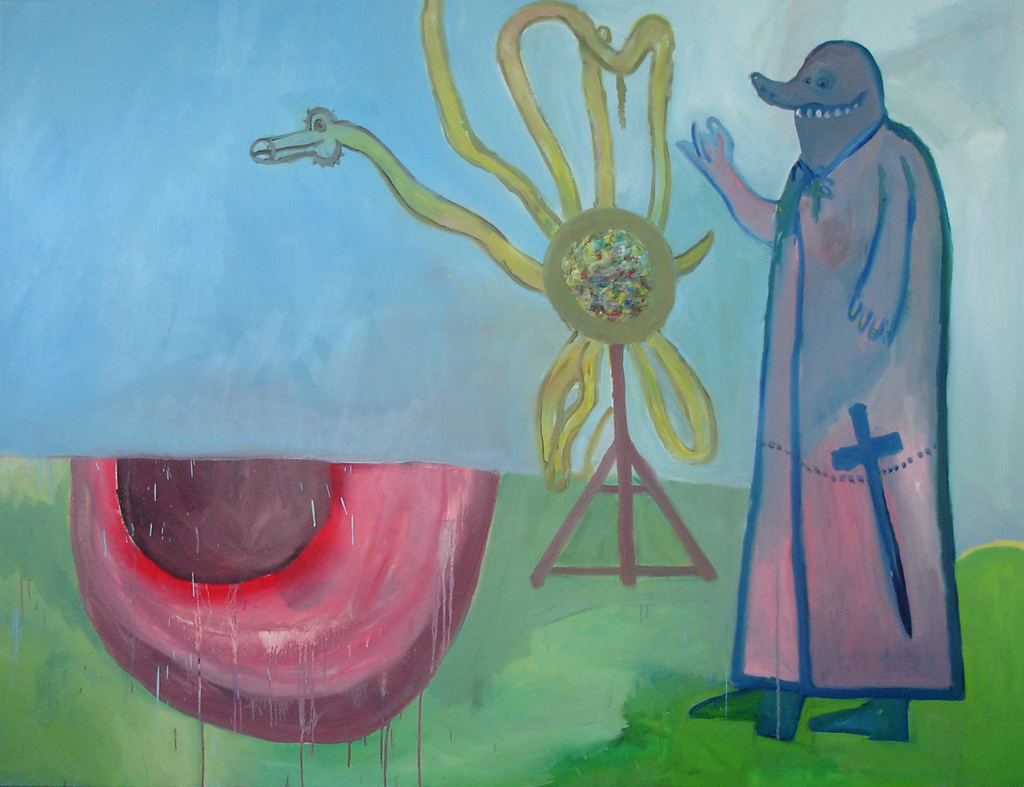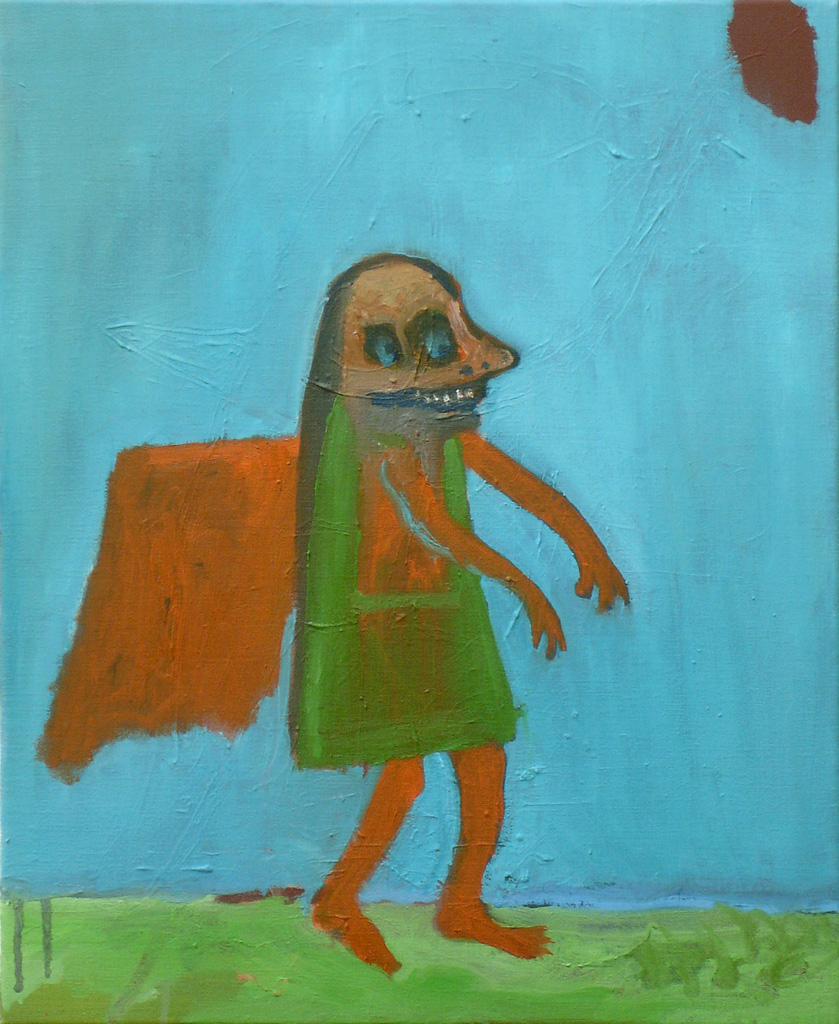

Oil painting on canvas

Oil painting on canvas

Oil painting on canvas


Oil painting on canvas

Oil painting on canvas

Oil painting on canvas

Oil panting on canvas

Oil painting on canvas

Oil painting on canvas

Oil painting on canvas
Tragedy and anguish
The tragedy of existence has always been at the centre of Vincent Gicquel's work. His latest works don't waver from this principle, on the contrary they radicalise this idea. While the characters of his older canvasses evolve in diffracted spaces, with intertwining plans savagely mistreating perspective, and could bring to mind the work of a Neo Rauch for example, the figures in his most recent paintings seem to be laid against a clogged-up surface, a wall of painting without depth, with nothing behind. An infinite fog of colour, like an asphyxiating drip, dull and crushing. What seems to be a « sky » in Hydre for example, cuts the canvas in two, and interrupts the movement with a circular shape on the left of the image; behind the character on the right, the sky comes too far forward. It is no longer a sky; it is a veil that is slowly lowering itself onto the surface of the earth. The drips, smudges and other intentional « mishaps » present in almost every canvas, assert the materiality of the painting and the flatness of the surface, and therefore play down the representativeness of the figures. We are in a saturated space, where matter runs everywhere, moves forward and covers the surface of things. The great coloured drip of a being, crushing everything in its silence. And everything is motionless, everything is mute, even the characters in action seem petrified. If, in the earlier canvasses, the absurdity of existence was staged like a series of mysterious tasks to be accomplished, one can see here figures at a loose end - allegorical but of what? - wandering through spaces without end, from which all depth is excluded, all breath. The sky, even blue and sprinkled with little white clouds like lambs, always imprisons these figures in the narrow circle of the horizon. One doesn?t know, for example, if in the Sans titre canvas, the character is panicking, all dressed in green, is running (from what? From who?) or if he is following (ditto), but it isn't important; one will always go round in circles, there will be no possible way out, nothing beyond the horizon. No obstacles will slow down the race: the world is empty, a pure area in which nothing ever existed. Some rare elements of vegetation attempt some leaves or branches, but look more like a lifeless mineral growth, than an organic being that could actually develop. In some canvasses, one has the impression that the characters' function is to check that nothing moves, that no form of life could ever develop; the character with the sword from the canvas entitled Hydre or the one from Incontinence, wearing a sort of cape like a cardinal, with a deathlike and yet lustful look. Even the almost angelic character of Poids isn't able to leave the ground, to assert the lightness of life and existence.
The release from the body
And no doubt the appearance of this character, in a position of domination over the character stripped bare, in the canvas that gives its title to the exhibition, must attract our attention, as a work on the release from the body seems to be happening here. If Gicquel's characters seem to struggle with matter, here on the contrary they seem to accept their materiality fully, their « bodyness ». The bodies are often naked, the characters are simply present, in the middle of life, and don?t seem to be struggling ? they are living. And the appearance of animals, in relation with these anthropomorphic figures, is no doubt meaningful from this point of view: the animal is naked, but doesn't know it. The animal is the being for which the problem of existence isn't in question : just being is not a problem for it. It is, to quote Heidegger, « poor in world »[1]; it doesn't reconfigure its world, using language for example - which is to be considered fortunate here, bad conscious and hatred for existence not being part of the possibilities of its world. « Incontinence » means first and foremost « the inability to curb ones desires », in the sexual sense, the « urologic » sense only deriving from this. Here it is about sexual incontinence, not to deplore it or castigate it, but to celebrate it; the body is first and foremost a vital power, that expresses itself - and eminently so - in the sexual act, that produces life, that allows it to circulate through beings and time. That is why, in the canvasses exhibited here, the bodies? power are shown in an explicit manner, the characters almost all displaying an oversized phallus, often of a different colour than the rest of their body. Corporal fluids flow, pour out, run: like painting. The bodies finally accept their seminal potential, and in these desolated spaces, it is the possibility of life free from the moral constraints hanging over sex namely, that appears. Everything seems to become sexual. Even Volcan becomes a phallus ejaculating seminal smoke, which a bird pecks at like a precious food. The tree branches of Fontaine echo the characters; phallus, and the crooked fingers of Ego resemble sexual appendices of a new genre. But sex is not genitality. It appears here like a seminal power, generative of nature, of the ability of Man to create worlds[2]. The latter is no longer this technology-crazed beast that the modern world has produced like a (Gestell) system[3]. He learns again to live innocently, that is to say, accepting and enjoying the body's powers. It is no doubt this, one of the first tasks of the artist.
Painting like a child
And it takes time. It is a long task that consists in observing the world with new and innocent eyes. Conquered and constructed innocence, rather than regained. Picasso said: « When I was a child, I drew like Raphaël. It took me all my life to learn to draw like a child. » The latter doesn?t have interpretative schemes of reality, other than those that naturally structure his perception; education is the process through which one inculcates what will enable him - or force him, as you wish - to understand the world in a manner similar to those who surround him. Regaining this innocence, is returning - which is impossible - to this state before the formation of interpretative schemes, is perceiving the world beyond the categorisations and the frames that structure the apprehension of daily life[4]. To paint like a child, is therefore to live like a child, to live before the invention of good and evil, before the moralisation of things. It is living beyond good and evil, because one cannot go back: we must go past them, imagine our own moral categories. Undoubtedly one must have to take this road, sometimes with a ferocious use of humour, even the worst - and Gicquel's canvasses show it quite well. To paint like a child is to create worlds, lay down new standards, new, unseen and groundless moral evaluations, assert interpretations of reality, knowing that none are adequate, that they are only nets thrown on the absurd chaos of being, to attempt to bring back, glistening like fish, more intense forms of life.
Guillaume Condello
[1] Heidegger, The Fundamental concepts of metaphysics. World-finitude-solitude., (1929-1930), NRF-Gallimard, coll. Philosophy library.
[2] Nietzsche says somewhere that having children must be a limited right: a sign of the Creator ?s responsibility when faced with his creature and the world that it lives in.
[3] Cf. Heidegger, The question of technique, (1954), in Essays and conferences, Galllimard, coll. TEL.
[4] Cf. The analysis that Goffman gives of these frames (Frames of experience, Minuit, coll. Le sens commun).